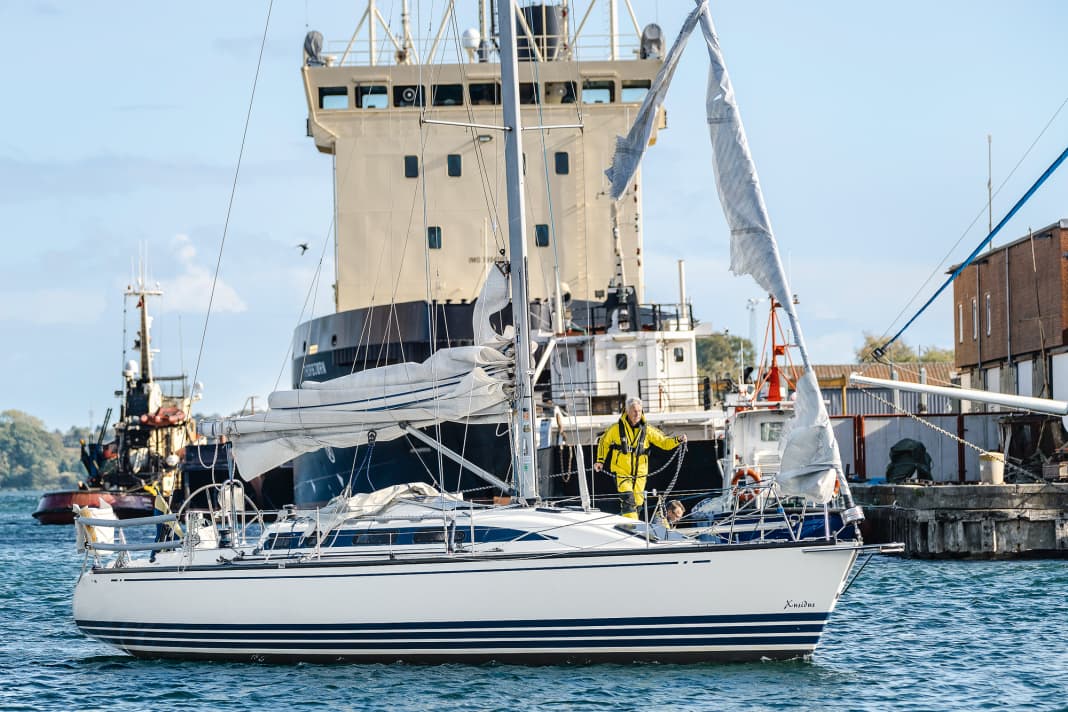Sail maintenance: Prevention and care - increasing the durability of the cloth
Michael Rinck
· 20.11.2023






This article is part of a sailing special. The contents:
The sails are the propulsion system of a sailing boat, but they often receive too little attention. If a boat is bought second-hand, the sails are usually older and the new owner has more important things to take care of first, such as the maintenance backlog on the installation and electrics, the diesel or urgent measures such as repairing a leaking hatch. In addition, new sails are a major investment, which often accounts for a significant proportion of the total value of an older boat.
But even with an older sail, it can be worth going to the sailmaker to get the old cloths ready for the coming seasons. Small tears can simply be taped or stitched, but without repair they can quickly become irreparably damaged. A damaged thimble can no longer properly transfer the forces that arise on the slider or stay rider into the sail, and it can tear at this point, but a new thimble can be hammered in by the sailmaker in just a few minutes.
There are also some attachments on the sail that are important for trim and stability and also need to be checked and replaced. The clamps for the leech lines often either no longer have any grip or are broken when the sail is struck. The same applies to the Velcro straps on the batten pockets or, on older designs, the elastic band that keeps the batten under tension. Wind lines also fray and can come loose, but are indispensable as a trimming aid.
Easy Fix
All these parts are easy to replace. It is particularly important to replace worn UV protection and patches on railing and spreader chafe areas. Even if the sail doesn't seem to last much longer, these are the things that can quickly render it unusable.
However, no sailmaker can completely restore a deformed profile; the cloth wears out over time and this process is irreversible. However, the luff rope in the luff can also contract over the years, whereby the sail expands in return. This causes the luff to gather, giving it a bulbous shape that can no longer be trimmed flat. Replacing the permanently installed line, which absorbs the force in the luff, can flatten the profile again and have a life-extending effect on the old sail.
Sail care: the best tips for preventing damage and problems






UV protection and regular checks by the sailmaker
However, you should not wait until the sail is already showing clear signs of damage before taking it to the sailmaker; a new cloth should also be checked regularly. The easiest way is to take the sails to an expert for an inspection at the end of the season. In this way, for example, chafe marks that have not yet been repaired with a patch can be discovered and major consequential damage prevented.
However, the most important factor in maintaining the value of a sail for as long as possible is good UV protection. The destructive effect of the ultraviolet spectrum of sunlight is enormous. The rays make the fabric rough and hard, causing it to become brittle and lose its strength, which eventually leads to tearing. The fabric itself cannot be protected when sailing, but it spends most of its life unfurled on the boom or rolled up on the forestay. A good tarpaulin or sewn-on UV protection is then particularly important for good protection.
Jens Burmester from Co-Segel an der Schlei shows us numerous cases of UV damage to his customers' sails in his workshop. According to the sailmaker, the luff of the mainsail is often affected: "The owners close the lazy bag but leave out the small tarpaulin between the mast and the boom. At this point, the sun can shine unhindered on the first few centimetres of the sail and attacks the material.
Sail care: Prevent spak
Almost as devastating for the cloth is spak, the small black spots that, like mould, are caused by moisture if a sail was not dry when it was packed or furled. However, sailors are faced with a dilemma here, because setting the sail in the harbour and letting it flap in the wind to dry is just as damaging.
If it has rained on the last few miles to the mooring on Sunday evening or there was a lot of spray, the crews have to go to the trouble of taking the sail down and spreading it out in the boat or on deck to dry. This is usually not necessary with the mainsail, as a good boom cover is ventilated enough to allow the sail to dry when unfurled. Unfortunately, this does not work with a furling genoa.
Precaution through timely reefing
Timely reefing is particularly important to maintain the profile. If the fabric is overloaded by excessive pressure, the shape of the sail also changes for the worse: it becomes more bulbous, can no longer be trimmed flat, and the deepest point of the profile shifts from the first third behind the luff further into the centre of the sail. As a result, the profile generates more pressure and less propulsion. In other words, the yacht pushes more, but is slower. It is then often necessary to reef much earlier.
The topic of cleaning and sealing is also interesting for maintaining value, but not for brand new sails, as these do not yet have any problems with soiling and spak and the fabrics have also been sealed by the manufacturer. However, if there is a problem with spak, cleaning can help to stop this very damaging process for the material. You can either clean the sail yourself with special solutions or send it to a professional. Ultramar in the Netherlands offers a cleaning service, as well as do-it-yourself products. After cleaning, it is important to apply a sealant because the old one has been washed away and will become ineffective over time anyway. It prevents the fabric from absorbing moisture. As a result, the sail dries faster and spackling is prevented.
Repair sails with on-board equipment
In the case of relatively new sails, sealing can slow down the ageing process of the fabric, and the same applies to old cloths, where cleaning has a particularly positive visual effect. But even if the old cloth shines again, a worn profile cannot be washed away. At some point, there is no way around a new purchase. Until that time comes, good care and maintenance can at least delay it.
Of course, damage can also occur without the possibility of being able to call on the help of a sailmaker directly. In this case, repairs must be carried out with on-board equipment. Repairs to small tears or holes are the easiest. You should always have a few patches of sail tape in your toolbox. Larger damage can perhaps be relieved by reefing if it has occurred in the lower or, in the case of furling sails, in the front area.
If in doubt, even if there is no suitable tape on board, repairs should always be carried out with the materials available, even with armour tape or an unsightly seam. After all, the aim is to get the boat into the next harbour and prevent the damage from becoming worse and even more expensive.
When a new cut is necessary
There may be cases where a recut makes sense. Sören Hansen from Elvström sees this possibility with Dacron genoas without battens in the leech. Here the fabric softens over time and the leech flutters. This can be controlled by tightening the leech lines, but then the sail also closes at the back. Cutting the leech a little more concave and removing the broken material can significantly improve the stability. This is not possible with laminates with fibres in the direction of the load, as this would cut through the fibres, soften the leech and make the problem even worse.
The lower profile of the mainsail, which moves aft, can be countered with more mast bend, which flattens the profile overall. In addition, in the case of fully battened sails without tapered battens, these can be retrofitted to shift the profile slightly forwards again, as this makes the sail stiffer at the rear and softer at the front.
However, completely recutting a sail is not an option. The costs would be enormous and the material would still be old afterwards. At some point, the only solution is to order a new sail - and give your boat a fresh drive.

